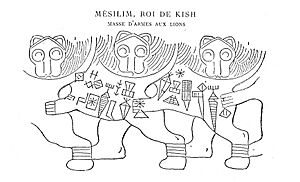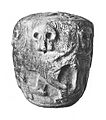Mesilim facts for kids
Quick facts for kids Mesilim𒈨𒁲 |
|
|---|---|
| King of Kish | |
 
Head of a votive mace with a lion-headed eagle (emblem of god Ningirsu) and six lions, dedicated at a shrine in Girsu by King Mesilim of Kish. Inscription in archaic script: “Mesilim, king of Kish, builder of the temple of Ningirsu, brought [this mace head] for Ningirsu, Lugalshaengur [being] prince of Lagash”. Louvre Museum.
|
|
| Reign | c. 2600 BC |
| Predecessor | Uhub |
| Successor | Mesannepada |
Mesilim (Sumerian: 𒈨𒁲), also known as Mesalim, was an important king of the ancient Sumerian city-state of Kish. He ruled around 2600 BC. Even though his name isn't on the famous Sumerian king list, we know about him from old writings and objects found by archaeologists.
Mesilim was a powerful ruler during a time called the "Early Dynastic III" period (around 2600–2350 BC). Records from his time show that he helped build temples in the cities of Adab and Lagash. This suggests he had some control or influence over these areas.
Contents
Mesilim: A Peacemaker King
Mesilim is most famous for helping to solve a big disagreement between two neighboring cities: Lagash and Umma. The problem was about who had the right to use an irrigation canal. This canal ran through a flat area called Gu-Edin, which was on the border between the two cities.
Solving the Border Dispute
To find a fair solution, Mesilim asked for guidance from the god Ishtaran. After this, he decided on a new border between Lagash and Umma. He then put up a special stone pillar to mark this new boundary. On the pillar, he wrote down his final decision for everyone to see.
The Pillar of Peace
This solution was meant to bring lasting peace, but it didn't last forever. Later, a king from Umma named Ush destroyed Mesilim's pillar. This was an act of defiance, showing that Umma didn't agree with the border anymore. These events are mentioned in the writings of a later ruler of Lagash, Entemena. They tell the story of how the border was first set between these two Sumerian cities.
𒈨𒁲 𒈗𒆧𒆠𒆤 𒅗 𒀭𒅗𒁲𒈾𒋫 𒂠 𒃷 𒁉𒊏 𒆠𒁀 𒈾 𒉈𒆕
me-silim lugal kiški-ke4 inim dištaran-na-ta eš2 gana2 be2-ra ki-ba na bi2-ru2
"Mesilim, king of Kiš, at the command of Ištaran, measured the field and set up a stele there."
Extract from the Cone of Enmetena, Room 236 Reference AO 3004, Louvre Museum.
Who Was King Mesilim?
Historians and archaeologists have studied old texts to learn more about Mesilim. In the 1950s, a scholar named Edmund Gordon thought that Mesilim might actually be the same person as King Mesannepada of Ur. Mesannepada also took the title "King of Kish" later in his reign.
Different Kings or One?
This idea came from an old Mesopotamian proverb. It talks about a king whose temple was torn down. In the Sumerian version, it mentions "Mesilim" and his temple. The later Akkadian version mentions "Mesannepadda." However, another scholar, Thorkild Jacobsen, disagreed. He believed Mesilim and Mesannepada were likely two different kings. He thought the Akkadian scribe might have just used a name they knew from the king list.
Mesilim's Contemporaries
We know from an inscription on a mace head that Mesilim lived at the same time as a king of Lagash named Lugalshaengur. This suggests that Mesilim ruled before the famous Lagash dynasty of Ur-Nanshe. Mesilim is also mentioned in other ancient writings. For example, two administrative tablets name him as a contemporary (and likely a ruler over) Lugalshaengur, who was the Governor of Lagash, and Nin-Kisalsi, who was the Governor of Adab.
An Inscription on a Bowl
One inscription found on a bowl reads:
{{Blockquote| me-silim lugal kisz e2-sar bur mu-gi4 nin-KISAL-si ensix(GAR.PA.TE.SI) adab
"Me-silim, king of Kish, to the Esar temple sent over (this) bowl (for the burgi ritual). Nin-KISALsi, (was) the governor of Adab."
Images for kids
-
Mesilim macehead with inscription Mesilim Lugal Kish (𒈨𒁲 𒈗 𒆧), "Mesilim, King of Kish".
-
Mesilim Lugal Kish-ki (𒈨𒁲 𒈗 𒆧𒆠), "Mesilim, King of Kish", on the "Net Cylinder" of Entemena
See also





